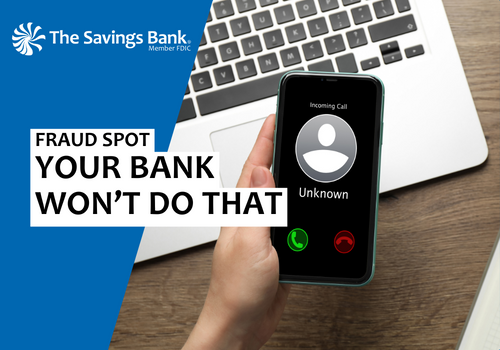Spotting Fraud: Your Bank Won't Do That
01/03/2024

Spotting Fraud: Your Bank Won’t Do That
The new year is here, and there is no better time to brush up on our fraud spotting skills!
Fraudsters often target consumers by pretending to be financial institutions. They may reach out through electronic means like emails, phone calls, texts, or even social media messages. Sometimes these communications are easy to spot because the messages will contain spelling errors, obvious logo spoofing, or unbelievable links. However, the cleverer the fraudster, the harder these scams can be to spot. Below are a few things your bank will never do that should make you suspicious of fraud.
- Ask you to download an unofficial app.
There are thousands of apps available in mobile stores like Google Play and not all of them are legitimate. Some fraudsters will develop mobile banking apps designed to look authentic to steal your password and username. If you are unsure which apps are approved by your bank or if someone reaches out to you asking you to download a “new” mobile app, call your bank at a trusted number to verify before downloading.
- Ask for full account numbers, passwords, usernames, PINs, or other identifying information.
Your bank will never reach out to you and ask for confidential information. While it is normal for your bank to ask for identifying information for verification purposes, they will only do so if you have reached out to them first. Your bank will never ask you for passwords, usernames, or PINs. This information should always remain with you and should not be shared.
- Ask you to perform a “test transaction” or send money to a different account.
If someone asks you to transfer money from your account into a “general bank account” either because they say your account has been hacked or to help the bank with a test transaction, they are a scammer. Your financial institution will not ask you to transfer money from one account to another and especially to an account which is not your own.
- Ask you to click a link to sign-in to your account.
Any unsolicited links—whether emailed, messaged, or texted—should always be regarded as suspicious; however, your bank will never ask you to login to your account via an unknown link. They will always direct you to login via the official app or website portal by your own initiation.
- Reach out via social media.
Your bank will never reach out to you via social media in order to conduct business—period. If someone is contacting you on social media claiming to be your bank, immediately block and report them.
If you experience one of the above situations, the best practice is to immediately stop all contact and call the number on the back of your bank card or a trusted phone number to your financial institution.
The best way to avoid fraud is to know what to look for! Unfortunately, every scam will not be easily identifiable, so it is important to know the warning signs that should arouse suspicion. If you or someone you know is the victim of a scam, call your bank and visit FTC.gov/scams to report fraud.

